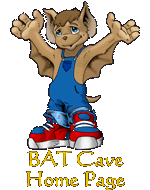   |
Be sure to click on any thumbnail image below to get a more detailed view of each picture! 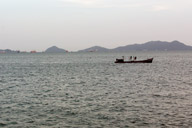 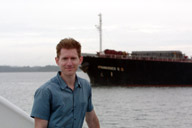 From August 12th through August 19th, 2004, I went on a vacation to
Panama, where I lived from 1971 to 1986. It was fun, there are a lot of
new things down there but I was surprised at how similar it still looked
to what I remember. They have several new highways that help with traffic
a lot, there is quite a bit of new construction, From August 12th through August 19th, 2004, I went on a vacation to
Panama, where I lived from 1971 to 1986. It was fun, there are a lot of
new things down there but I was surprised at how similar it still looked
to what I remember. They have several new highways that help with traffic
a lot, there is quite a bit of new construction,
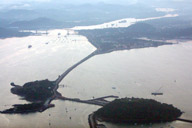 especially on the
Amador Causeway which has a bunch of new restaurants with several more being
built, but the major landmarks are still there and very recognizable. Most
things seemed to be in good repair, the Canal itself was very busy and
seemed to be operating smoothly pretty much at full capacity. The regional
airport at Paitilla is gone, and now trips into the interior take off from
Albrook Field, the old United States Air Force base. especially on the
Amador Causeway which has a bunch of new restaurants with several more being
built, but the major landmarks are still there and very recognizable. Most
things seemed to be in good repair, the Canal itself was very busy and
seemed to be operating smoothly pretty much at full capacity. The regional
airport at Paitilla is gone, and now trips into the interior take off from
Albrook Field, the old United States Air Force base.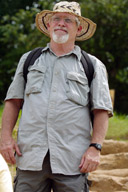 Since it had been so long since I lived in Panama, and when I did live
there it was in the former Canal Zone, which was an American community
separate from the rest of Panama (meaning my Spanish is terrible and my
memories of the roads hazy), I decided to go with a tour company
instead of trying to get around by myself. I went with "Panama
Jones" tours, since they offered a complete canal transit and their
tour took me close to things I wanted to see, so I was with a tour group
of six other people most of the time: a couple from Cleveland, Ohio and
four members of a family from Weehawken, New Jersey. I had investigated cruise
ships initially but it turns out most cruise ships don't actually transit
the canal, they just go through the Gatun locks on the Atlantic side and
then turn around and go back into the Caribbean, which I wasn't interested
in at the moment. Since it had been so long since I lived in Panama, and when I did live
there it was in the former Canal Zone, which was an American community
separate from the rest of Panama (meaning my Spanish is terrible and my
memories of the roads hazy), I decided to go with a tour company
instead of trying to get around by myself. I went with "Panama
Jones" tours, since they offered a complete canal transit and their
tour took me close to things I wanted to see, so I was with a tour group
of six other people most of the time: a couple from Cleveland, Ohio and
four members of a family from Weehawken, New Jersey. I had investigated cruise
ships initially but it turns out most cruise ships don't actually transit
the canal, they just go through the Gatun locks on the Atlantic side and
then turn around and go back into the Caribbean, which I wasn't interested
in at the moment.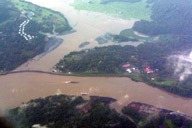 I arrived by air in the
evening on August 12th, the pilot brought the plane in right along the
Canal on the Pacific side, I started recognizing the terrain as we flew
past Gamboa, the I arrived by air in the
evening on August 12th, the pilot brought the plane in right along the
Canal on the Pacific side, I started recognizing the terrain as we flew
past Gamboa, the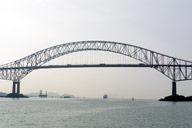 Pacific side locks, and the Thatcher Ferry Bridge. Pacific side locks, and the Thatcher Ferry Bridge.Bright and early the next day we toured Old Panama, the original Spanish buildings from the 1500s. Balboa was next, I got photos of some of the houses we lived in, the 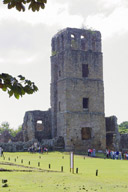 Croton Street house, the
Barnaby Street house, and the Los Rios house, but we only drove past Gamboa by boat and train so I couldn’t get the older Gamboa houses.
The YMCA in Balboa is still there, being used as a commerical building for
a few businesses including the Panama Jones tour company and an artisan
market selling native goods that was in Stevens Circle when I lived there. Croton Street house, the
Barnaby Street house, and the Los Rios house, but we only drove past Gamboa by boat and train so I couldn’t get the older Gamboa houses.
The YMCA in Balboa is still there, being used as a commerical building for
a few businesses including the Panama Jones tour company and an artisan
market selling native goods that was in Stevens Circle when I lived there.
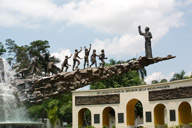 The old DENI police station that used to be across the street from that
(and was destroyed during Just Cause)
has been replaced by a giant statue that was pretty impressive looking. The old DENI police station that used to be across the street from that
(and was destroyed during Just Cause)
has been replaced by a giant statue that was pretty impressive looking.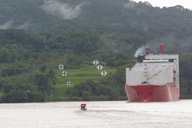 Then we did
the full Panama Canal transit, it looks
almost exactly the way I remember, it seemed to be in good shape and they
were very busy, bringing something like 42 ships through a day, which is
pretty much a nonstop pace. Then we did
the full Panama Canal transit, it looks
almost exactly the way I remember, it seemed to be in good shape and they
were very busy, bringing something like 42 ships through a day, which is
pretty much a nonstop pace.
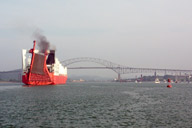 I don't think I
had ever actually transited the entire canal, it was interesting to go
through all the locks, Gaillard Cut, past Gamboa, and into Gatun Lake like
all the ships do. We were on the Isla Contadora boat,
it's a mid-size sightseeing launch that is small enough to fit through the
locks with another ship as long as that ship is smaller than the "Panamax"
size, which takes up the entire lock chamber. I don't think I
had ever actually transited the entire canal, it was interesting to go
through all the locks, Gaillard Cut, past Gamboa, and into Gatun Lake like
all the ships do. We were on the Isla Contadora boat,
it's a mid-size sightseeing launch that is small enough to fit through the
locks with another ship as long as that ship is smaller than the "Panamax"
size, which takes up the entire lock chamber.
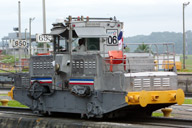 Since our boat was
small, we didn't get assisted through the locks by the "mules" like big ships do, but I
did see the mules in action quite a bit. The transit as a whole was very
peaceful, quiet for the most part with just some occasional clanging and
horn blowing to indicate ships' progress through the canal. Since our boat was
small, we didn't get assisted through the locks by the "mules" like big ships do, but I
did see the mules in action quite a bit. The transit as a whole was very
peaceful, quiet for the most part with just some occasional clanging and
horn blowing to indicate ships' progress through the canal.The funny part was I think we set the record for the slowest transit ever. 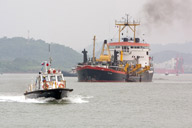 The boat was an hour late
leaving the dock, then our special canal pilot was an hour late getting to
us, then there were so many Panamax ships in the canal that we had to wait
for a smaller one to get clearance through Gatun locks so we could fit in
the chamber with it, that took another 90 minutes, then when we The boat was an hour late
leaving the dock, then our special canal pilot was an hour late getting to
us, then there were so many Panamax ships in the canal that we had to wait
for a smaller one to get clearance through Gatun locks so we could fit in
the chamber with it, that took another 90 minutes, then when we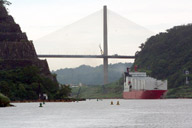 finally
reached the dock in Colon, a huge sailboat was already there that took up
the entire dock, so our pilot took another 45 minutes to find a clear spot
to dock! finally
reached the dock in Colon, a huge sailboat was already there that took up
the entire dock, so our pilot took another 45 minutes to find a clear spot
to dock!
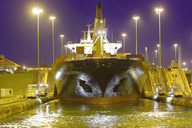 It was fun though, got
tons of pictures. It was fun though, got
tons of pictures.Panama has just finished a new bridge across the canal called Puente Centenario, or the Centennial Bridge, we went under it but it had not quite opened for cars yet. 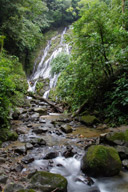 Next on the itinerary was El Valle, a very picturesque "valley" that is
actually the crater of a giant extinct volcano about a 90 minute drive
from Panama City. There was less up there than
I remember, although we went to a nice Next on the itinerary was El Valle, a very picturesque "valley" that is
actually the crater of a giant extinct volcano about a 90 minute drive
from Panama City. There was less up there than
I remember, although we went to a nice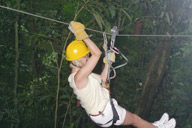 waterfall called "El Chorro de
Macho", which
I'm told got its name from ancient warriors proving their manliness by
jumping off the falls. Some of our tour group elected to rappel through
the rainforest canopy there which was kind of neat. We also
went to the local Sunday market where they sell all sorts of fresh fruit
and vegetables, plus handmade souvenir items. waterfall called "El Chorro de
Macho", which
I'm told got its name from ancient warriors proving their manliness by
jumping off the falls. Some of our tour group elected to rappel through
the rainforest canopy there which was kind of neat. We also
went to the local Sunday market where they sell all sorts of fresh fruit
and vegetables, plus handmade souvenir items.
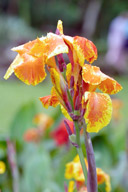 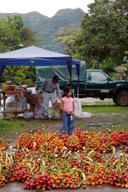 Then we went to a nice
zoological garden there that had a lot of native plants and both native
and non-native animals. Then we went to a nice
zoological garden there that had a lot of native plants and both native
and non-native animals.On the way back from El Valle we passed the popular Pacific coast beaches that I remember, Rio Mar and Coronado. Coronado has been really built up, there's even a big grocery store at the entrance which is a big change from how it was when I was there. 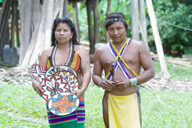 Then we visited an
Emberá village
deep within the rainforest off the Chagres river. The Emberá are a native
"Indian" race that have for the most part kept their customs and
traditions. They showed us their tradeskills, costumes, and way of life. Then we visited an
Emberá village
deep within the rainforest off the Chagres river. The Emberá are a native
"Indian" race that have for the most part kept their customs and
traditions. They showed us their tradeskills, costumes, and way of life.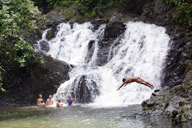 The women served us a lunch of their traditional foods, patacones, which is
fried plantain, kind of like a not-sweet banana, and tilapia fish, which
was very good.
The women served us a lunch of their traditional foods, patacones, which is
fried plantain, kind of like a not-sweet banana, and tilapia fish, which
was very good.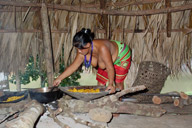 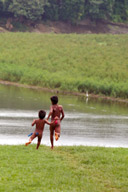 After an invigorating hike through the rainforest, we reached the Emberá's favorite swimming hole, just beneath a nice waterfall. 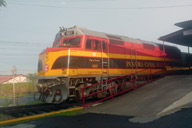 On our final day
we took the newly renovated Panama Canal Railway across the isthmus
to Portobelo, On our final day
we took the newly renovated Panama Canal Railway across the isthmus
to Portobelo,
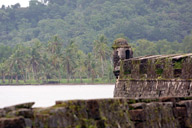 which is the former major Spanish port on the Atlantic
coast. It still has the ruins of two major forts right in town, complete
with cannons. There is a larger fort further out in the jungle called San
Lorenzo that we used to go to, but our guide said the road was too rough
to get over now, so we couldn't see it on this trip. which is the former major Spanish port on the Atlantic
coast. It still has the ruins of two major forts right in town, complete
with cannons. There is a larger fort further out in the jungle called San
Lorenzo that we used to go to, but our guide said the road was too rough
to get over now, so we couldn't see it on this trip.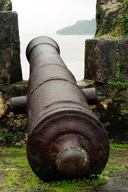 It briefly rained quite heavily, August
falls within the rainy
season in Panama but rain was only a problem on a couple days, it usually
cleared right up after short, hard rains. It briefly rained quite heavily, August
falls within the rainy
season in Panama but rain was only a problem on a couple days, it usually
cleared right up after short, hard rains. The Railway itself is quite nice, they have a luxurious 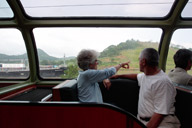 passenger car with full service, it was an
enjoyable if crowded run across the isthmus, the track parallels the Canal
so there are some great sights of the canal and the jungle. passenger car with full service, it was an
enjoyable if crowded run across the isthmus, the track parallels the Canal
so there are some great sights of the canal and the jungle.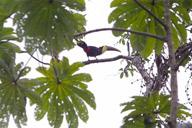 As we were
returning from Portobelo, our guide Chuck Shirley took us for a quick
animal-viewing trip through San Lorenzo Park, which is just across Gatun
Locks. This was the only time we got good looks at native wildlife, we
were able to see toucans, howler monkeys, and a sloth all along the same
stretch of jungle. As we were
returning from Portobelo, our guide Chuck Shirley took us for a quick
animal-viewing trip through San Lorenzo Park, which is just across Gatun
Locks. This was the only time we got good looks at native wildlife, we
were able to see toucans, howler monkeys, and a sloth all along the same
stretch of jungle.The next day I returned here to Sugar Land, Texas! It was a fun trip, very interesting to see all the landmarks I remember from when I was living in Panama. Perhaps I'll return to see more of the western mountains, beaches, and wildlife! |